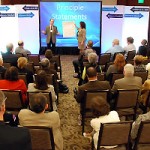
The Summit on Future Directions for CTE: Getting to Where We Want To Go
4th and last in the series
A leader takes people where they want to go. A great leader takes people where they don’t necessarily want to go but ought to be. – Rosalyn Carter
Â
 In the last post on the Fall Summit I shared that states ended day two by voting on the 24 principles that were crafted during the small group work. I can’t emphasize how grateful I am to all the Summit attendees. Everyone took the charge of defining the Future Directions for CTE very seriously. Attendees brainstormed, crafted, drafted, worked and reworked words until they became statements and statements until they became principles. This is really hard work. And attendees gave it their all!
In the last post on the Fall Summit I shared that states ended day two by voting on the 24 principles that were crafted during the small group work. I can’t emphasize how grateful I am to all the Summit attendees. Everyone took the charge of defining the Future Directions for CTE very seriously. Attendees brainstormed, crafted, drafted, worked and reworked words until they became statements and statements until they became principles. This is really hard work. And attendees gave it their all!
Â
Here is a sampling of the principles. This will give you a sense of the tone and spirit of the principles that were crafted:
• CTE is an educational engine geared toward a high skills, high wage, high performance workforce for the global innovation economy.
• CTE is a collaboration between business/industry and education (K-12 through adult) that must be flexible and collaborative in its delivery of education.
• Education is deliberate, relevant and authentic for every student, and is accessible without limitations of time and place.
** Note: We have made the decision not to share the 24 principles on the blog. These 24 principles are really raw material that taken out of context might be misinterpreted. We do have a plan for gathering additional input and sharing the next steps in this process. See below.
Voting Results: Much like Election Day, we all were waiting anxiously for the results to come in. The goal of the “straw poll†was to determine how close to consensus we were. Were we a divided community? Did we need to go back to the drawing board? Did the principles go far enough? Did the principles go too far?

Of the 24 principles, seven had the support of more than 90% of the voting states. The voting states comprised all but five states. One could say that consensus achieved among these top seven principles was a slam dunk. Wow! These top seven principles clearly represented the major themes/priorities that CTE must focus on during the next ten years.
 Choosing Our Words Carefully: With the principles now drafted, we chose to tackle a question that was raised by an attendee on day one – “when we say a term like ‘program of study’ do we all agree on the same definition of what this is and what it looks like to implement this well?†Attendees nodded their heads “yes, but of course we agree and understand these terms. We are all CTE leaders.†However, it became evident during the small group work that even among the selected group at the Summit, terms like programs of study, rigor, seamless and articulation have very different meanings, interpretations and implementation. Attendees spent some time on day three crafting common definitions for 14 terms but this work is far from complete. A charge for us in the future!
Choosing Our Words Carefully: With the principles now drafted, we chose to tackle a question that was raised by an attendee on day one – “when we say a term like ‘program of study’ do we all agree on the same definition of what this is and what it looks like to implement this well?†Attendees nodded their heads “yes, but of course we agree and understand these terms. We are all CTE leaders.†However, it became evident during the small group work that even among the selected group at the Summit, terms like programs of study, rigor, seamless and articulation have very different meanings, interpretations and implementation. Attendees spent some time on day three crafting common definitions for 14 terms but this work is far from complete. A charge for us in the future!
 So Where Do We Go From Here?: Our Board of Directors met on November 9 to review the Summit work/outcomes and to approve a ‘go forward’ plan that includes a webinar for Summit attendees and a series of regional calls with the state directors in December, as well as a Board of Directors’ retreat in January where the Board will finalize the vision and principles. On February 17, 2010 at 2 pm eastern we will host a webinar to unveil the new vision and corresponding principles. And at the NASDCTEc spring meeting in Washington, D.C. we will once again roll up our sleeves and work together to craft the action steps to achieve our new vision.
So Where Do We Go From Here?: Our Board of Directors met on November 9 to review the Summit work/outcomes and to approve a ‘go forward’ plan that includes a webinar for Summit attendees and a series of regional calls with the state directors in December, as well as a Board of Directors’ retreat in January where the Board will finalize the vision and principles. On February 17, 2010 at 2 pm eastern we will host a webinar to unveil the new vision and corresponding principles. And at the NASDCTEc spring meeting in Washington, D.C. we will once again roll up our sleeves and work together to craft the action steps to achieve our new vision.
 Looking Ahead: Our organization’s efforts to define a new vision for CTE is not about dismantling what we have in place or discrediting the success we have achieved so far. Instead, it is about looking back on what we have achieved and learning from both our successes and failures. It is about ensuring that the opportunities before CTE are maximized. It is about staying relevant in an ever-changing educational and economic environment. We can’t be what we always have been. In 2009, we don’t look like what we did in 1999; and we shouldn’t look today like we will look like in 2019. We can build on what we have accomplished. With a new vision guiding our work and the right leadership in place, we can get to where we ought to be!
Looking Ahead: Our organization’s efforts to define a new vision for CTE is not about dismantling what we have in place or discrediting the success we have achieved so far. Instead, it is about looking back on what we have achieved and learning from both our successes and failures. It is about ensuring that the opportunities before CTE are maximized. It is about staying relevant in an ever-changing educational and economic environment. We can’t be what we always have been. In 2009, we don’t look like what we did in 1999; and we shouldn’t look today like we will look like in 2019. We can build on what we have accomplished. With a new vision guiding our work and the right leadership in place, we can get to where we ought to be!

